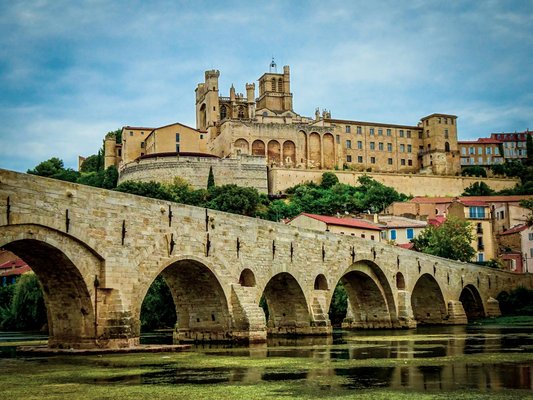This ancient Roman settlement in southern France has 2,000-year-old stone roads, a Gothic cathedral, and a daily covered market. Located near Mediterranean beaches and Languedoc vineyards.
Narbonne, a city in southern France's Occitanie region, offers a rich tapestry of experiences. You can walk on 2,000-year-old Roman stones, climb medieval towers for panoramic views, or savor fresh oysters at a bustling market. Located near both vineyards and Mediterranean beaches, Narbonne serves as an ideal base to explore the flavors and landscapes of the Languedoc area.
Experiencing Local Flavors at Les Halles
Les Halles, Narbonne's covered market, opens every day from 7 am to 2 pm. This Art Nouveau building from 1901 houses over 60 vendors selling fresh produce, meats, cheeses, and seafood. You can try regional specialties like oysters from nearby Gruissan or goat cheeses from the Languedoc countryside. The market also has several small restaurants where you can enjoy a casual lunch of local dishes. The lively atmosphere and variety of products make Les Halles a central part of Narbonne's daily life.
Strolling Along the Canal de la Robine
The Canal de la Robine, an offshoot of the Canal du Midi, flows through the center of Narbonne. You can walk along its tree-lined banks or take a boat tour to see the city from the water. The Merchants' Bridge spans the canal, lined with colorful houses and shops. As you browse the stores on the bridge, you might not realize you're crossing water. The canal provides a pleasant backdrop for a relaxed afternoon walk or a picnic on its banks.
Exploring Medieval Architecture
The city's medieval buildings are prominent in Narbonne. The Archbishop's Palace has towers dating back to the 13th and 14th centuries. Inside the palace, you'll find two museums with collections of art and archaeological finds. Next to the palace stands the Cathedral of Saint-Just and Saint-Pasteur, an example of southern Gothic architecture. Although the cathedral was never completed, its 42-meter-high choir demonstrates the ambition of medieval builders. You can climb the Gilles Aycelin dungeon for views of the city and surrounding landscape.
Discovering Vineyards and Beaches
Narbonne sits in the Languedoc-Roussillon wine region, France's largest by area. You can visit nearby wineries to taste local varieties like Corbières and Minervois. Many vineyards offer tours where you can learn about the wine-making process and the characteristics of the local terroir. For a day at the beach, head to Narbonne Plage, about 15 km from the city center. This long stretch of sandy Mediterranean coastline is suitable for swimming, sunbathing, and water sports during the warmer months. The beach area also has restaurants and shops catering to visitors.
Uncovering Roman Narbonne
Narbonne's Roman history is visible throughout the city. In the main square, you can step on the original stones of the Via Domitia, the first Roman road built in Gaul to connect Italy and Spain. To learn more about ancient Narbo Martius, visit the Narbo Via museum, which opened in 2021. The museum houses over 6,000 artifacts from Roman times, including a wall displaying 760 carved stone blocks from ancient funerary monuments. This collection shows aspects of daily life in the Roman colony.
Navigating Narbonne and Its Surroundings
You can get to Narbonne by train, with direct services from Paris, Barcelona, and other major cities. Once in Narbonne, you'll find the city center compact and easy to walk around. For trips to the beach or nearby towns, you can use local buses or rent a car. Cycling is also popular, with dedicated paths along the canal and to the coast. If you're interested in exploring the wider region, consider day trips to places like the walled city of Carcassonne or the oyster beds of Bouzigues on the Étang de Thau.



















